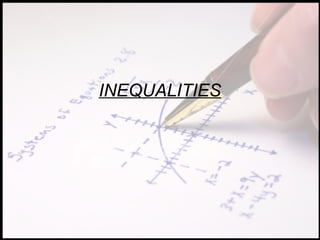
Inequalities ppt revised
- 1. INEQUALITIES
- 2. Equal or Unequal? • We call a math statement an EQUATION when both sides of the statement are equal to each other. – Example: 10 = 5 + 3 + 2 • We call a math statement an INEQUALITY when both sides of the statement are not equal to each other. – Example: 10 = 5 + 5 + 5
- 3. Inequality Signs • We don’t use the = sign if both sides of the statement are not equal, we use other signs. GREATER THAN GREATER THAN (OR EQUAL TO) > > LESS THAN LESS THAN (OR EQUAL TO) < <
- 4. DON’T FORGET THIS!!! • THE BIGGER SIDE OF THE SIGN IS ON THE SAME SIDE AS THE BIGGER # • THE SMALLER SIDE OF THE SIGN IS ON THE SAME SIDE AS THE SMALLER # – Examples: 10 < 15 or -4 > -12
- 5. Let’s Try Some! •3 < 5 •2 < 7 • 22 > 10 • -65 < -62 • -10 < 4 • 32.3 < 32.5
- 6. Our Friend, The Number Line • A number line is simply this… …a line with numbers on it. • We use a number line to count and to graphically show numbers. – Example: Graph x = 5.
- 7. Graphing Inequalities • Graph x = 2 A “closed” circle ( ) indicates we include the number. • Graph x < 2 An “open” circle ( ) • Graph x < 2 indicates we DO NOT include the number. • Graph x > 2 By shading in the number line we are indicating that all the • Graph x > 2 numbers in the shade are also possible answers.
- 8. You Try This… • Graph x < 10
- 9. You Try This… • Graph x > -4
- 10. You Try This… • Graph x > 200
- 11. You Try This… • Graph x ≥ 7
- 12. Write the following inequalities: 5. Seven is less than or equal to three less than two times a number. 7 ≤ 2x – 3 6. The sum of two numbers is greater than six less than the first number. x+y>x-6 7. Eleven more than a number, divided by five is less than eighteen. x + 11 < 18 5
- 13. Let’s Go Shopping! • Last week you went shopping at the mall. You had $150 to spend for the day. You bought a shirt for $25 and some jeans for $40. You also spent $5 on lunch. You wanted to purchase a pair of shoes. What is the maximum amount of money you could have spent on the shoes? The amount you The cost of The maximum have spent the shoes amount you have
- 14. How much can the shoes cost? $25 + $40 + $5 + x ≤ $150 $70 + x ≤ $150 -$70 -$70 X ≤ $ 80 The cost of the shoes • Basically, the shoes must cost less than or equal to the amount you have left!
- 15. Do You Really Understand? • Let’s see if this makes sense… 3<9 (If we add 6 to both sides, is the inequality true?) 3+6 < 9+6 9 < 15 YES!
- 16. Do You Really Understand? • Let’s see if this really makes sense… 10 > 4 (If we subtract 3 from both sides, is the inequality true?) 10-3 > 4-3 7>1 YES!
- 17. Do You Really Understand? • Let’s see if this still really makes sense… 8 < 12 (If we multiply both sides by 2, is the inequality true?) 8(2) < 12(2) 16 < 24 YES!
- 18. Do You Really Understand? • Let’s see if this still really makes sense… 8 < 12 (If we multiply both sides by -2, is the inequality true?) 8(-2) < 12(-2) THIS STATEMENT IS NOT TRUE. WE -16 < -24 NEED TO FLIP THE INEQUALITY SIGN TO MAKE THIS A TRUE STATEMENT. -16 > -24
- 19. Solving Inequalities • So apparently there are a few basic rules we have to follow when solving inequalities. • If you break these rules you will answer the question incorrectly! • DON’T BREAK THE RULZ!
- 20. Rule #1 • Don’t forget who the bigger number is! – Example: 9>x – It is okay to rewrite this statement as x<9 – If 9 is bigger than “x”, that means that “x” is smaller than 9.
- 21. Rule #2 • When multiplying or dividing by a negative number, reverse the inequality sign. – Example: -5x > 15 -5 -5 X < -3
- 22. Solve Each Inequality & Graph Example 1: m + 14 < 4 -14 -14 m < -10
- 23. Solve Each Inequality & Graph Example 2: -7 > y-1 +1 +1 -6 > y y < -6
- 24. Solve Each Inequality & Graph Example 3: (-3) k < 10(-3) -3 k > -30
- 25. Solve Each Inequality & Graph Example 4: 2x + 5 ≤ x + 1 -x -x x+5 ≤ 1 -5 -5 x < -4